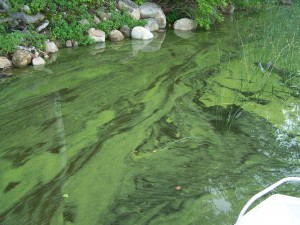EFFINGHAM — Province Lake, with its shallow, sandy beaches, clear water and proximity to seasonal camps and a golf course, attracts vacationers and locals alike. A collaborative watershed protection effort led by the Province Lake Association seeks to protect the lake and its 7.3-mile watershed area so that it remains healthy and attractive for humans and wildlife alike.
According to the Province Lake Association, the 1,008-acre lake — 70 percent of which is in New Hampshire, with 30 percent in Maine — has experienced more frequent blooms of potentially toxic algae in recent years. The state Department of Environmental Services considered the lake as “impaired” due to high phosphorus and chlorophyll a. levels, according to PLA Chair Carl Davis.
Most recently, the state issued a cyanobacteria advisory on June 21 that was lifted on June 28, in time for the long, hot Independence Day weekend. The advisory was issued after cyanobacteria was found off Bonnyman Road.
According to the state DES advisory sent to the PLA Association, a cyanobacteria advisory is not a lake closure.
“Our assessment of cyanobacteria (formerly called blue-green algae) involves a microscopic evaluation which serves only as a precautionary measure for short-term exposure to cyanobacteria. Our recommendation is to avoid contact with any area of water experiencing a bloom. Ingestion of the bloom/scum is one of our primary concerns. Keep pets out.”
This past Friday, members of the Haskell family clan hung out on the private beach area owned by Happy Hallow Campground on a stretch of sand with views of Green Mountain and the Maine side of the lake.
Susan Haskell of Haverhill, Mass., said 40 members of her family were gathering for the holiday weekend at Happy Hollow Campground. Family members were relaxing on the private beach area owned by the campground which is located right off Route 153, where the beach area is nearly level with the road.
Haskell was aware of the PLA watershed protection program, but not necessarily aware of the most recent cyanobacteria advisory in the lake off Bonnyman Road, some distance away.
On a hot and sunny day such as Friday, the focus was on the family gathering and enjoying the water.”This is one of the best lakes around,” she said, adding that it was safe for the kids, shallow with a sandy bottom, and a roped off area for swimming. Province Lake is only 17 feet deep.”It’s just beautiful here,” she said.
Province Lake Association Past President Carl Davis, a member of the association’s board, said the association has been around since the mid-1970s. The state DES has been conducting water quality sampling about four times per year for the past 22 years. More recently, the membership undertook an extensive study, collaborating with state and local agencies including NH DES, the State of Maine Department of Environmental Protection, the Acton Wakefield Watersheds Alliance, the Green Mountain Conservation Group, F.B. Environmental Associates of Portland, Maine and Portsmouth, the towns of Wakefield and Effingham in New Hampshire, and Parsonsfield, Maine and other local volunteers to develop the plan.
“Our main concern is phosphorous,” said Davis. When levels of that nutrient rise, a bit it serves as fertilizer so weeds and algae grow faster. We’re really trying to further understand how that is impacting the lake,” he said, adding the study will try to address and identify human causes for elevated phosphorous levels that may include failed septic systems.
“Our lake is impacted by humans in two ways — through the roads, like Route 153, Bailey and Bonnyman roads when water runs off rapidly, carrying anything that has been on the road or sediment,” he said. The phosphorous attaches to the dirt particles that get rinsed into the lake and released into the water.
Phosphorous may also flow downstream to the lake from properties where fertilizers are being used. He said stormwater runoff could be slowed or diverted in a number of ways. The groups will work with the AWWA’s Youth Conservation Corps to help homeowners identify and create rainwater diversion methods to prevent phosphorous or nutrient ridden rainwater from flowing into the lake.
Davis said the environmental consultant from F.B. Environmental is conducting more advanced testing — such as tests for dissolved oxygen levels — as part of the watershed study. Asked how the most recent rains will affect the lake quality, he said he didn’t know, but hoped that the study will help determine whether the rain has flushed out, or flushed in, more nutrients.
An overview of the study will be presented at the Province Lake Association meeting to be held on July 20 at Province Lake Golf Course on Route 153. The meeting will begin with the business portion at 9 a.m., followed by a presentation from F.B. Environmental.
For more information, go to the newly designed PLA website at www.provincelake.org.
lmulkern@newstote.com


